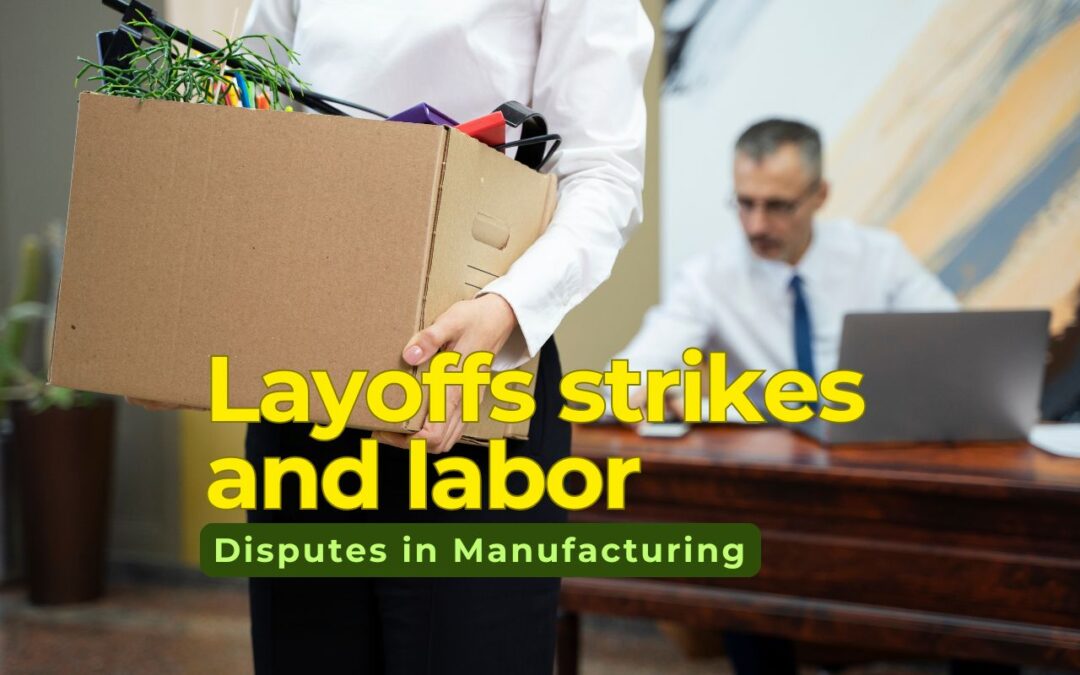In the fast-paced and high-stakes world of manufacturing, businesses constantly navigate economic shifts, evolving consumer demands, and technological advancements. While adaptability is essential, periods of instability can lead to difficult workforce decisions—layoffs, strikes, and labor disputes. Managing these situations legally, ethically, and strategically is crucial for protecting a company’s reputation, maintaining productivity, and avoiding costly legal consequences.
This comprehensive guide dives into how manufacturers can legally and effectively handle layoffs, strikes, and labor disputes, emphasizing legal compliance, employee communication, conflict resolution, and long-term strategy.
Understanding the Legal Framework
Before taking any action, businesses must understand the legal boundaries set by labor laws, which vary across jurisdictions but generally aim to protect workers’ rights while balancing employer interests. Whether it’s a large-scale layoff or a labor strike, the legal implications can be significant.
Key legal protections that businesses must be aware of include:
- Employment law that governs contract termination
- Collective bargaining rights of unionized workers
- Workplace safety and conditions regulations
- Discrimination and retaliation protections
- Notice requirements under mass layoff laws or industrial relations regulations
Legal compliance is not optional; failure to follow the correct process can result in litigation, financial penalties, and reputational damage.
1. Handling Layoffs Legally and Compassionately
Layoffs, while sometimes necessary, are emotionally and operationally complex. Legal compliance during this process is critical to avoid lawsuits and maintain organizational morale.
A. Evaluate the Business Case
Before initiating layoffs, businesses should conduct a thorough financial and operational assessment. Identify whether layoffs are genuinely necessary or if other cost-cutting alternatives (such as furloughs, job-sharing, or voluntary retirement) could be more appropriate.
B. Review Employment Contracts and Labor Agreements
Examine individual employment contracts, collective bargaining agreements, and local labor laws. These documents often outline notice periods, severance pay, or specific layoff procedures that must be followed.
C. Provide Legal Notice
Many jurisdictions require advance written notice of mass layoffs. This notice must be timely and include key details, such as the reason for termination, the number of employees affected, and the effective date. Legal guidelines vary depending on the number of employees and the nature of the layoff.
D. Ensure Fair Selection Criteria
Layoffs must be based on objective and nondiscriminatory criteria, such as tenure, performance history, or job classification. Avoid any appearance of bias based on age, gender, race, or union involvement, as this could lead to discrimination claims.
E. Offer Support and Transition Assistance
Providing severance packages, outplacement services, and counseling can ease the transition for affected workers and show good faith. While not always legally required, these actions reflect positively on the company and reduce negative publicity or backlash.
2. Managing Strikes Lawfully and Strategically
Strikes, particularly in unionized manufacturing environments, can bring operations to a standstill. However, employees often have a legal right to strike under labor laws that protect collective bargaining.
A. Understand the Type of Strike
Strikes can take many forms—economic strikes over wages, unfair labor practice strikes, sympathy strikes, or wildcat (unauthorized) strikes. Identifying the type is essential because legal rights and obligations vary accordingly.
B. Maintain Open Lines of Communication
In many cases, strikes result from communication breakdowns. Proactively engaging with union representatives or worker committees may prevent escalation. Regular dialogue and transparency are essential for resolving issues before they result in work stoppages.
C. Respect Legal Strike Rights
Employers must not retaliate against workers for engaging in lawful strikes. Disciplining or terminating striking workers can lead to legal consequences. However, the law may allow replacement workers under specific circumstances, especially during economic strikes, but with legal limitations.
D. Document Incidents and Preserve Evidence
During a strike, document all incidents, communications, and interactions with employees. This recordkeeping is essential in case the dispute results in legal proceedings or arbitration.
E. Negotiate in Good Faith
Employers are legally obligated to negotiate in good faith with recognized unions. Refusing to bargain or engaging in surface negotiations (going through the motions without genuine intent) can be considered an unfair labor practice.
3. Addressing Labor Disputes Effectively
Labor disputes are broader than strikes and may involve grievances, disagreements over contract interpretation, wage issues, or concerns about working conditions. Effective dispute management involves legal compliance, mediation skills, and organizational awareness.
A. Set Up Clear Grievance Procedures
An effective grievance process allows workers to raise concerns and ensures management addresses them promptly. This should include defined steps, from informal discussions to formal hearings or third-party arbitration.
B. Investigate Complaints Thoroughly
Employers must take every grievance seriously. Conduct independent investigations, gather evidence, and avoid making assumptions. Rushed or biased investigations may be challenged legally and could exacerbate the issue.
C. Avoid Retaliation at All Costs
Employees must feel safe reporting grievances. Retaliation—whether subtle or overt—can lead to legal action and deteriorate trust. Encourage a workplace culture where issues are resolved respectfully and transparently.
D. Consider Alternative Dispute Resolution
Mediation and arbitration can resolve conflicts faster and with less animosity than court battles. These approaches allow for collaborative problem-solving and often yield mutually beneficial outcomes.
E. Educate Supervisors and Managers
Often, labor disputes arise from misunderstandings or mismanagement. Regularly train supervisors on labor law compliance, workplace sensitivity, and employee relations best practices. Front-line managers play a pivotal role in maintaining workplace harmony.
4. Building a Culture That Prevents Future Conflict
Long-term labor stability cannot be achieved through reactive measures alone. Proactive strategies foster a resilient and cooperative workforce, even during turbulent times.
A. Foster Open Communication
Transparency is crucial, especially during change. Share information about company performance, changes in policies, or market shifts. When employees feel informed, they are less likely to assume the worst and more likely to support necessary changes.
B. Involve Employees in Decision-Making
Employees who feel heard are more engaged. Whether through suggestion programs, feedback surveys, or joint labor-management committees, involving workers in discussions can reduce friction and generate practical solutions.
C. Promote Workplace Fairness
Perceived injustice—whether in promotions, disciplinary actions, or workload distribution—can fuel discontent. Ensure consistency, clarity, and fairness in all policies and practices.
D. Invest in Employee Well-Being
Demonstrating care for workers through wellness programs, safe working conditions, and career development opportunities helps to build loyalty and reduce labor unrest.
E. Review and Update Labor Policies Regularly
Laws evolve, and so do workplace expectations. Regularly update your labor policies to reflect current legal requirements and industry standards. Engage legal counsel to ensure that handbooks, contracts, and dispute resolution protocols are compliant.
5. Responding to Government and Regulatory Scrutiny
Layoffs, strikes, and labor disputes may attract attention from labor boards, inspectors, or even the media. Managing these situations with legal and strategic foresight can prevent regulatory violations and protect your company’s image.
A. Cooperate with Authorities
During investigations, provide complete and timely documentation. Show a willingness to comply with regulations and rectify any mistakes. A cooperative approach typically leads to more favorable outcomes.
B. Monitor Industry Trends and Legislative Changes
Manufacturing businesses must stay updated on changes to labor laws, union rules, and government requirements. Ignorance of the law is not a defense and may result in penalties or reputational harm.
C. Seek Legal Counsel When Needed
If faced with a strike or mass layoff, consult with legal professionals to ensure all actions align with labor laws. Proactive legal advice can help avoid litigation and ensure a smoother resolution.
Final Thoughts
Layoffs, strikes, and labor disputes are some of the most challenging aspects of managing a manufacturing business. These situations test leadership, legal compliance, and ethical integrity. Mishandling them can cripple operations, tarnish reputations, and lead to legal consequences that haunt businesses for years.
However, with a proactive approach grounded in law, empathy, and transparency, manufacturers can manage these challenges effectively. Whether you’re facing a workforce reduction, responding to labor unrest, or navigating contract disputes, prioritize clear communication, legal guidance, and fairness.
Building trust today can be the most powerful investment in labor stability tomorrow. Every layoff notice, grievance, and negotiation is an opportunity—not only to meet legal requirements—but to define the kind of workplace culture and leadership your company stands for.












